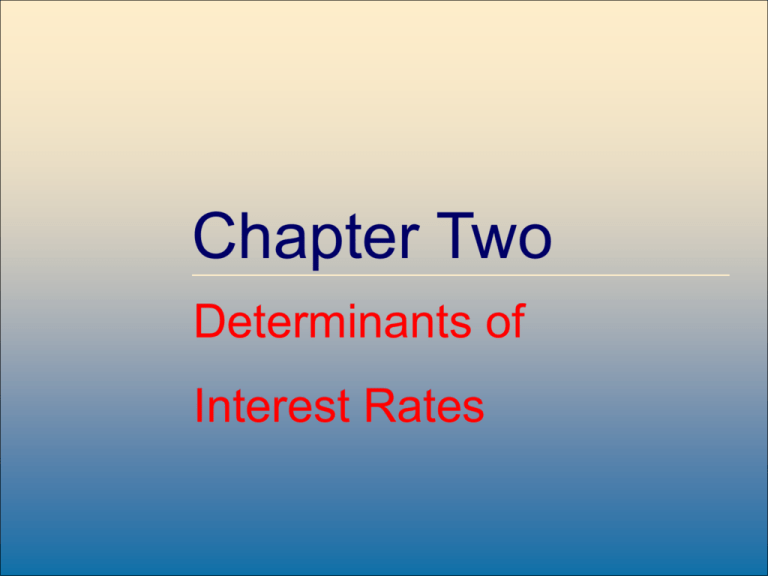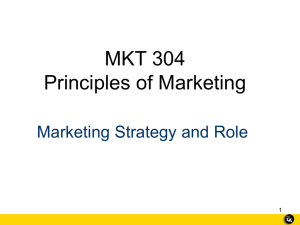
Chapter Two
Determinants of
Interest Rates
McGraw-Hill /Irwin
2-1
Copyright © 2007 by The McGraw-Hill Companies, Inc. All rights reserved.
Chapter Outline
1.
2.
3.
4.
Time Value of Money Review
Effective Rate vs. Quoted Rates
Loanable Funds Theory
Factors Affecting Nominal Interest
Rates
5. Term Structure of Interest Rate
6. Forecasting Interest Rate
McGraw-Hill /Irwin
2-2
Copyright © 2007 by The McGraw-Hill Companies, Inc. All rights reserved.
Interest Rate Fundamentals
• Nominal interest rates - the interest rate
actually observed in financial markets
– directly affect the value (price) of most
securities traded in the market
– affect the relationship between spot and
forward FX rates
McGraw-Hill /Irwin
2-3
Copyright © 2007 by The McGraw-Hill Companies, Inc. All rights reserved.
1. Time Value of Money Review
1. Compound interest vs. simple interest
2. Present Value and Future Value of Lump
Sum and Annuity
PV=FV (PVIFr,t)=FV(PVIFi/m,nm)
PV=PMT (PVIFAr,t)=PMT(PVIFA i/m,nm)
FV=PV (FVIFr,t)=PV(FVIF i/m, nm)
FV=PMT(FVIFAr,t)= PMT(FVIFAi/m, nm)
McGraw-Hill /Irwin
2-4
Copyright © 2007 by The McGraw-Hill Companies, Inc. All rights reserved.
Calculating Present Value of a Lump Sum
• You are offered a security investment that pays $10,000 at
the end of 6 years in exchange for a fixed payment today.
•
PV = FV(PVIFi/m,nm)
•
at 8% interest = $10,000(0.630170) = $6,301.70
•
at 12% interest = $10,000(0.506631) = $5,066.31
•
at 16% interest = $10,000(0.410442) = $4,104.42
McGraw-Hill /Irwin
2-5
Copyright © 2007 by The McGraw-Hill Companies, Inc. All rights reserved.
Calculation of Future Value of a Lump Sum
• You invest $10,000 today in exchange for a fixed payment at
the end of six years
•
FV = PV(FVIFi/m,nm)
• at 8% interest = $10,000(1.586874) = $15,868.74
• at 12% interest = $10,000(1.973823) = $19,738.23
• at 16% interest = $10,000(2.436396) = $24,363.96
McGraw-Hill /Irwin
2-6
Copyright © 2007 by The McGraw-Hill Companies, Inc. All rights reserved.
Relation between Interest Rates and
Present and Future Values
Present
Value
(PV)
Future
Value
(FV)
Interest Rate
Interest Rate
McGraw-Hill /Irwin
2-7
Copyright © 2007 by The McGraw-Hill Companies, Inc. All rights reserved.
2. Effective or Equivalent Annual Return
(EAR)
Rate earned over a 12 – month period taking
the compounding of interest into account.
EAR = (1 + r) c – 1
Where r = period rate
c = number of compounding periods per year
McGraw-Hill /Irwin
2-8
Copyright © 2007 by The McGraw-Hill Companies, Inc. All rights reserved.
3. Loanable Funds Theory
• A theory of interest rate determination that
views equilibrium interest rates in financial
markets as a result of the supply and
demand for loanable funds
McGraw-Hill /Irwin
2-9
Copyright © 2007 by The McGraw-Hill Companies, Inc. All rights reserved.
Supply and Demand of Loanable Funds
Demand
Supply
Interest
Rate
Quantity of Loanable Funds
McGraw-Hill /Irwin
2-10
Copyright © 2007 by The McGraw-Hill Companies, Inc. All rights reserved.
Funds Supplied and Demanded by Various
Groups (in billions of dollars)
Funds Supplied Funds Demanded
Households
Business - nonfinancial
Business - financial
Government units
Foreign participants
McGraw-Hill /Irwin
$34,860.7
12,679.2
31,547.9
12,574.5
8,426.7
2-11
$15,197.4
30,779.2
45061.3
6,695.2
2,355.9
Net
$19,663.3
-12,100.0
-13,513.4
5,879.3
6,070.8
Copyright © 2007 by The McGraw-Hill Companies, Inc. All rights reserved.
Factors Shifting Demand & Supply Curve
• Supply
–
–
–
–
–
Wealth
Risk of financial security
Near-term spending needs
Monetary expansion
Economic conditions
• Demand
– Utility derived from asset purchased with borrowed funds
– Restrictiveness of nonprice conditions
– Economic conditions
McGraw-Hill /Irwin
2-12
Copyright © 2007 by The McGraw-Hill Companies, Inc. All rights reserved.
Effect on Interest rates from a Shift in the
Demand Curve for or Supply curve
Increased supply of loanable funds
Interest
Rate
Increased demand for loanable funds
SS
DD
DD
SS*
DD*
i**
i*
McGraw-Hill /Irwin
i*
E*
Q* Q**
E*
E
E
i**
SS
Quantity of
Funds Supplied
2-13
Q* Q**
Quantity of
Funds Demanded
Copyright © 2007 by The McGraw-Hill Companies, Inc. All rights reserved.
4. Factors Affecting Nominal Interest
Rates
• Inflation
– continual increase in price of goods/services
• Real Interest Rate
– nominal interest rate in the absence of inflation
• Default Risk
– risk that issuer will fail to make promised
payment
(continued)
McGraw-Hill /Irwin
2-14
Copyright © 2007 by The McGraw-Hill Companies, Inc. All rights reserved.
• Liquidity Risk
– risk that a security can not be sold at a
predictable price with low transaction cost on
short notice
• Special Provisions
– taxability
• Term to Maturity
McGraw-Hill /Irwin
2-15
Copyright © 2007 by The McGraw-Hill Companies, Inc. All rights reserved.
Inflation and Interest Rates: The Fisher
Effect
• The nominal interest rate should compensate
an investor for both expected inflation and the
opportunity cost of foregone consumption, the
real rate component
i = RIR + Expected(IP)
or
RIR = i – Expected(IP)
• Example(p. 47): 3.49% - 1.60% = 1.89%
McGraw-Hill /Irwin
2-16
Copyright © 2007 by The McGraw-Hill Companies, Inc. All rights reserved.
Default Risk and Interest Rates
The risk that a security’s issuer will default
on that security by being late on or missing
an interest or principal payment
DRPj = ijt - iTt
Example for December 2003:
DRPAaa = 5.66% - 4.01% = 1.65%
DRPBaa = 6.76% - 4.01% = 2.75%
McGraw-Hill /Irwin
2-17
Copyright © 2007 by The McGraw-Hill Companies, Inc. All rights reserved.
Liquidity Risk and Interest Rates
The risk that a security need to be sold at low
prices because of inactive trading
LRPj = ijt - iTt
McGraw-Hill /Irwin
2-18
Copyright © 2007 by The McGraw-Hill Companies, Inc. All rights reserved.
Tax Effects: The Tax Exemption of Interest on
Municipal Bonds
Interest payments on municipal securities are
exempt from federal taxes and possibly state and
local taxes. Therefore, yields on “munis” are
generally lower than on equivalent taxable bonds
such as corporate bonds.
im = ic(1 - ts - tF)
Where:
McGraw-Hill /Irwin
ic =
im =
ts =
tF =
Interest rate on a corporate bond
Interest rate on a municipal bond
State plus local tax rate
Federal tax rate
2-19
Copyright © 2007 by The McGraw-Hill Companies, Inc. All rights reserved.
Term to Maturity and Interest Rates:
Yield Curve
(a) Upward sloping
(b) Inverted or downward
sloping
(c) Flat
Yield to
Maturity
(a)
(c)
(b)
Time to Maturity
McGraw-Hill /Irwin
2-20
Copyright © 2007 by The McGraw-Hill Companies, Inc. All rights reserved.
5. Term Structure of Interest Rates
• Unbiased Expectations Theory
– at a given point in time, the yield curve reflects the
market’s current expectations of future short-term
rates
• Liquidity Premium Theory
– investors will only hold long-term maturities if they
are offered a premium to compensate for future
uncertainty in a security’s value
• Market Segmentation Theory
– investors have specific maturity preferences and will
generally demand a higher maturity premium
McGraw-Hill /Irwin
2-21
Copyright © 2007 by The McGraw-Hill Companies, Inc. All rights reserved.
6. Forecasting Interest Rates
• Forward rate is an expected or “implied” rate on a
security that is to be originated at some point in the
future using the unbiased expectations theory
• Spot rate is the yield to maturity of a zero-coupon
bond
_
_
1/2 - 1
R
=
[(1
+
R
)(1
+
(
f
))]
1 2
1 1
2 1
where
2 f1
McGraw-Hill /Irwin
= expected one-year rate for year 2, or the implied
forward one-year rate for next year
2-22
Copyright © 2007 by The McGraw-Hill Companies, Inc. All rights reserved.





